
Water is the lifeline in homes, not just for drinking, but cooking, cleaning, and many other household activities. However, imagine if your water supply was suddenly cut off due to a natural disaster or a plumbing incident?
It's an anxious thought. Luckily, you can gain peace of mind and safeguard your family by implementing a few practical water storage strategies.
Identifying Proper Water Storage Containers
Sourcing the right containers for storing water is your first step. You must ensure they're food-grade quality to ensure the chemicals in the plastic don't seep into your water. Food-grade containers are often marked with a wine glass and a fork symbol.
Finding a container that's dark or opaque is also essential. Light can promote the growth of bacteria or algae in your stored water which will compromise its quality. If you cannot find dark containers, store them in dark areas instead.
There is a broad assortiment of water tanks available for any specific need and correctly store large amounts of water. If you live in an area prone to natural catastrophes like brush fires or severe storms, investing in these large units would be a wise decision.
Rigid Water Containers (RWCs) should have airtight lids to prevent any potential contaminants from entering. Containers previously containing juices or milk should be avoided as they can harbor microbes which could spoil your stored water.
Sanitizing Water Storage Containers
Before filling up any container with water for storage, it needs to be sanitized properly. This step is crucial to prevent microbial contamination thereby extending the shelf life of the stored water.
You can sanitize your containers by rinsing them with mild dish soap followed by rinsing with a bleach solution and then finally, a thorough rinse with clean water. This will ensure all residual soap and bleach is removed.
For the bleach solution, the Federal Emergency Management Agency (FEMA) suggests a ratio of 1 teaspoon of bleach to a quart of water. Ensure the bleach is non-scented and without any added cleansers or fabric softeners.
Bleach effectively kills bacteria, viruses, and other pathogens that can potentially contaminate stored water making it unsafe for consumption. Wipe down exteriors of containers as well, if they've been in dirty environments.
Maintaining Stored Water Quality
The quality of stored water can deteriorate over time due to physical, chemical and biological factors. Hence, it's necessary to treat it before storage.
Treating can be done by boiling the water for at least one minute. Alternatively, you can use water disinfection tablets or liquid solutions available from camping stores or online retailers. Always follow the instructions on these products carefully.
If none of these options are available, you can use unscented household chlorine bleach. The American Red Cross recommends 8 drops per gallon of water, stirring well and waiting 30 minutes before using.
Storage Duration and Rotation Strategies
The appropriate duration for storing water largely depends on how well it was purified or disinfected prior to storage. However, as a rule of thumb, you should replace your stored water every six months.
Earmarking specific dates twice a year, such as when daylight savings time begins and ends, can be helpful reminders for when to rotate your water supply. Consuming the old stock first ensures none goes to waste as you introduce fresh supplies into your storage.
Water doesn't go bad per se, but can acquire an off-taste due to absorbed odors from the air or containers. Regular replacement keeps your stored waters tasting fresh.
By employing a systematic cycling system together with careful monitoring for leaks or container damage, you ensure the safety of your water at all times.
Best Locations for Water Storage
To ensure your water stays fit for consumption, take note of the storage location. A secure water supply shouldn't only be convenient but also lessen chances of contamination or damage. Storage location should depend on available space, container size, and the environmental conditions.
A basement is often an ideal spot. It's typically cool, dark, and away from direct sunlight to deter bacterial growth. However, if you live in a flood-prone area, it might not be the best option. The Centers for Disease Control and Prevention (CDC) suggests places free from natural disasters like earthquakes or flooding for water storage.
If a basement isn't feasible, consider other cool and dark areas in your home like pantries or closets. If possible, do avoid storing waters near chemicals or any strong odors as the stored water might absorb them.
To maintain orderliness and clean surroundings around your containers, think of leveraging shelving units or customized storage racks.
Storing Water for Different Uses
Storage systems from the likes of The Water Tank Factory can be used for different purposes. Sustaining a family goes beyond drinking water; hygiene is equally important. Therefore, reserve separate supplies for cleaning, sanitation purposes and cooking aside from drinking.
For cooking and hygiene purposes, clean tap water can be used. However, always use purified or disinfected water for drinking to ensure safety. Remember to accustom everyone in your family to differentiate these storage units.
Drinking: Stored potable water should be strictly used for drinking or meal preparation only.
Cleaning: Designate a separate supply for cleaning dishes, kitchen surfaces, or washing hands.
Sanitation: Finally, consider a separate supply for flushing toilets or for cleaning purposes in emergencies.
Label your containers clearly to avoid confusion and maintain the distinct supplies of water for particular uses.
How to Use Stored Water Safely
Safe usage of stored water depends on strict adherence to cleanliness practices - how you access the stored water is as important as the method of storage. Start by keeping a dedicated ladle or cup specifically for dispensing stored water.
Avoid touching the inside of containers or reusing glasses as this invites contamination. Upon noticing any changes in smell, taste or appearance of your stored water, DO NOT consume it. Any cloudiness or oddities should warrant immediate disposal followed by a process of disinfecting the container prior to refilling it.
A noteworthy point; when you refill your supply from commercial sources like grocery stores, ensure they adhere to sanitization processes and their source of water is reliable. It's always worth prioritizing safety above everything else.
Emergency Water Purification Methods
In cases of utmost urgency or lack of resources, there are a few emergency methods to purify water. Hydration for everyone is vitally important, but water must be clean and potable.
One of the most common methods is boiling. Boiling water for at least one minute can kill bacteria and make it safe for drinking. Remember, this method also requires fuel and functional stoves. Therefore, those living in regions prone to power outages should consider alternatives.
Chemical treatment is another option including iodine tablets or bleaching. However, certain pathogens aren't affected by these methods, hence people with weakened immune systems should still boil their water.
A third option could be water filters. Modern technology has given rise to portable ones for personal use. Investing in these can greatly simplify the purification process during emergencies.
The Final Sip
Storing water for family use requires vigilance and proper practices to maintain quality and safety. Locations used for storing water should have optimum conditions to preserve the freshness of the supply while understanding different uses can help allocate better supplies for various tasks.
Recognize that different climates require adjusted storage strategies and implement efficient methods when using stored waters to avert any contamination. During emergencies when normal supplies might be disrupted, acquaint yourself with viable purification techniques that cater to your specific situation.



























